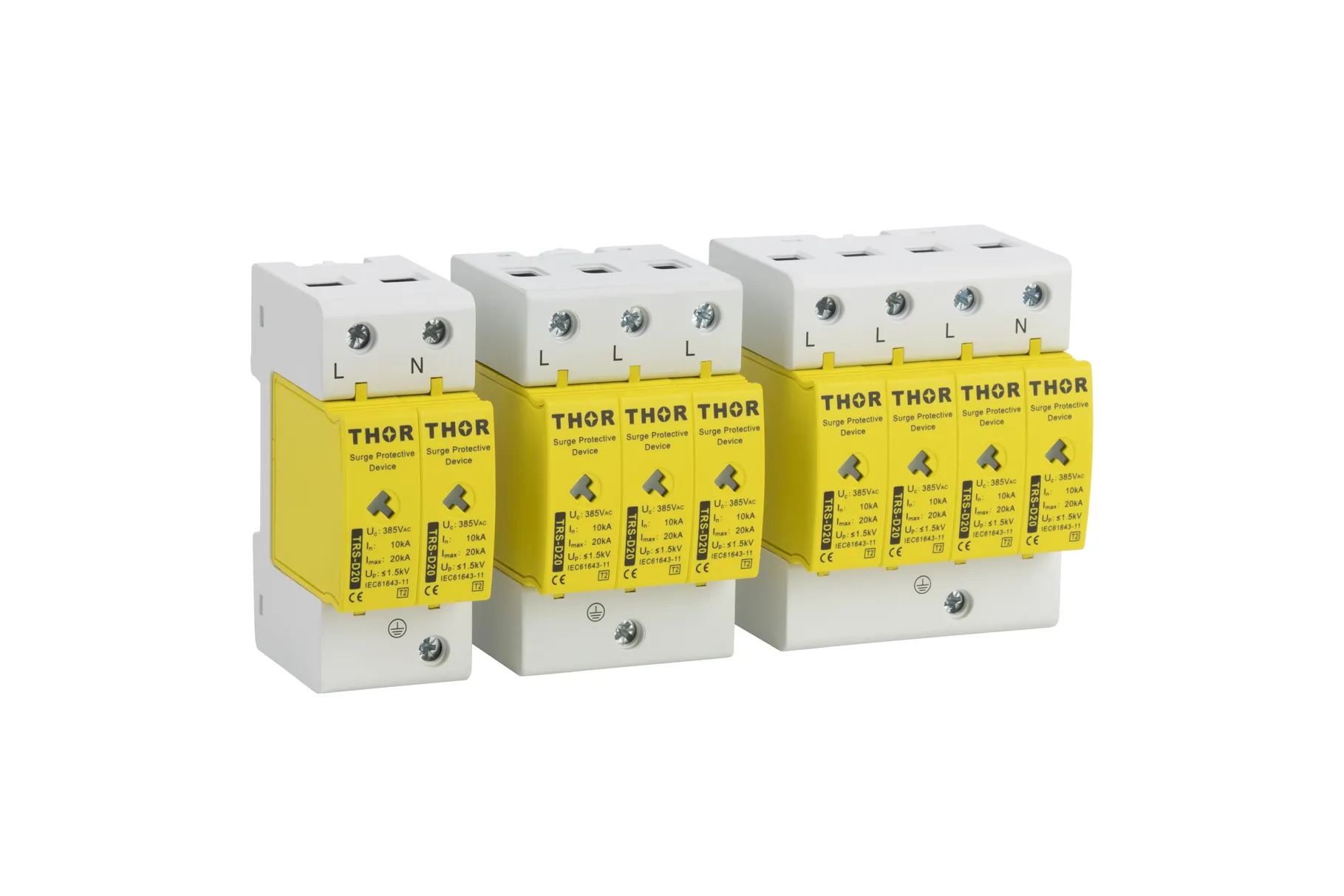What is an AC surge protective device?
AC SPD is installed in alternating current circuit systems to protect electrical equipment from voltage spikes caused by lightning, switching, or equipment failure.
How do I choose AC surge protective device?
Protecting sensitive and valuable electronic equipment from voltage spikes is crucial, so choosing the right AC Surge Protective Device (SPD) is important. When selecting an AC SPD, please keep in mind the following considerations:
- Identify the power supply type as single-phase or three-phase. Single-phase is used in homes and small businesses with a voltage of 220V. Three-phase is used in large commercial and industrial settings with a voltage of 380V.
- Choose the appropriate voltage protection level (UP). The lower the UP value of the Surge Protective Device, the better the protection for the equipment. It is generally recommended to select a UP value below 20% of the equipment’s voltage withstand rating.
- Select an SPD with the appropriate number of ports based on the number of devices you need to protect.
- Choose an SPD with TUV standard certification. TUV standards indicate that the SPD complies with safety and performance standards.
- Select an SPD size that matches the load you need to protect. Choosing an SPD that is too large may result in performance overflow, while choosing one that is too small may not provide sufficient protection.
- Choose an SPD with fault indication. Fault indication can quickly and timely inform us of the SPD’s status. Common fault indications include LED indicators and audible alarms.
How to install AC SPD?
Adequate preparation and correct installation can ensure that an AC SPD provides effective protection for electrical equipment. Before installation, ensure you are using the appropriate AC SPD by referring to the section “How do I choose AC SPD?” Installation tools such as pliers, screwdrivers, etc., need to be prepared in advance. The power supply at the installation site also needs to be confirmed shut off repeatedly. It’s important to note that electrical standards vary by region, and installers must be very familiar with them to ensure the installation complies with local standards.
Installation and testing steps:
Ensure the power is off. Reconfirm that the power supply to the SPD installation site is disconnected and use a voltmeter to measure.
Connect the SPD. Follow the manufacturer’s instruction manual to connect the SPD’s output and input terminals.
Grounding. Ensure the SPD is properly grounded. Check that the grounding wire is securely connected to the ground bus or a dedicated grounding rod.
Label information tags. Affix labels on the SPD indicating the installation date, product model, and other important information such as precautions.
Restore power. After reconnecting the power supply, use a voltmeter to test the SPD’s wiring for normal operation and check the SPD’s output voltage, among other information.
The following table illustrates the differences in installation between AC SPD and DC SPD.
Feature | AC SPD | DC SPD |
Wiring Method | Hot and neutral wires | Positive and negative terminals |
SPD Type | MOV | TVS diode or other semiconductor devices |
Installation Location | Near distribution box or meter box | Multiple locations in a photovoltaic system |
Grounding Requirements | Required | More stringent |
Maintenance and Replacement | Regular inspection and maintenance | More frequent inspection and replacement |
AC SPD not working
When an AC Surge Protection Device (SPD) is not working properly, it can be due to various issues. Here are some common problems listed:
Current Surges Exceeding Specified Capacity
If the current surge exceeds the SPD’s maximum handling capability, it can cause the SPD to lose performance. This may also happen due to a sudden increase in load or when power is cut off, leading to overvoltage or undervoltage conditions. Such issues can also arise after significant electrical events like lightning strikes.
Incorrect Installation
Improper installation of the SPD can lead to malfunction. This includes incorrect wiring and grounding methods, missing phases, screws not tightened to the proper torque, excessive distance between the SPD and the connection panel, and transformer no-load conditions.
Internal Component Failure, End of Product Life
SPDs have a limited lifespan. Each surge impact accelerates the wear and tear of internal components. Even if surges are infrequent, the internal components of the SPD will gradually lose effectiveness over time. The actual product lifespan can be referred to in the manufacturer’s product manual.
Damage Caused by External Environment
Harsh external weather conditions can also accelerate SPD failure. Factors such as humidity, heat, direct sunlight exposure, and frequent excessive vibrations can contribute to this. The SPD product’s casing rating and operating temperature range can guide in these situations.
Electrical Wiring Connection Issues
Electrical wiring problems in the facility can also cause SPDs to malfunction. Such issues are often found in older houses where wiring may be corroded, chewed by animals, or connections are loose, leading to the SPD not working correctly.
Compatibility Issues
Failure to correctly choose an AC SPD according to the type of circuit can lead to compatibility issues. This includes the circuit voltage, the type of protection provided by the SPD, etc., resulting in the surge protection device not being compatible with the specific model of the unit. Such issues should be avoided before the installation process.

